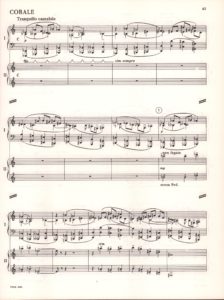Concerto for Two Pianos is an underappreciated and little-known piece by Roman Maciejewski written in the 1930s during the composer’s stay in Paris on a scholarship. Initially divided into four movements, it was modified in the 1980s and today consists of three movements: Allegro, Corale and Fuga e Variazioni. In addition, the title of the work was changed from Concerto pour deux piano solo to Piano duo concertante.
Maciejewski displays here excellent compositional skills, builds a well-thought-out formal structure, synthetises in it various elements borrowed from polyphonic and homophonic forms, and draws in an original manner on the tradition of the classical concerto. In this conglomerate of references we will also find more modern solutions, especially in the harmonic layer, where, in addition to clearly defined tonal centres, the composer uses the material of a full chromatic scale.
Its ostinato nature brings the piece closer to the achievements of Igor Stravinsky (whose Concerto for Two Pianoswas apparently an inspiration for Maciejewski), with the composer keeping the leading role of melody. The situation is similar in the case of the status of the two instruments – the second piano is not there only to accompany the first but is a fully-fledged member of the duo.
This is probably the first Concerto for Two Pianos in the history of Polish music and at the same time a flagship example of a neoclassical piece in Maciejewski’s oeuvre, with which the composer began a series of other works for this instrumental line-up. Looking at his entire oeuvre qualitatively, there are quite a few of those (especially if we take into account transcriptions).
- R. Maciejewski, Pianoduo concertante, cover (PWM Edition)
- R. Maciejewski, Pianoduo concertante, Fuga e variazioni, score excerpt (PWM Edition)
- R. Maciejewski, Pianoduo concertante, Corale, score excerpt (PWM Edition)
- R. Maciejewski, Pianoduo concertante, Allegro, score excerpt (PWM Edition)



